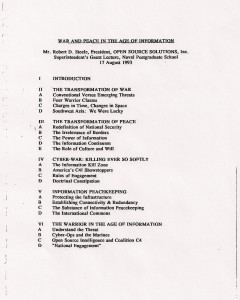1993 On Defense & Intelligence–The Grand Vision
About the Idea, Articles & Chapters, Briefings & Lectures
In 1993 the Prime Minister of France was furious with his intelligence community. His direct aide for intelligence was Col Louis Dilais, a former chief of the Americas branch in French military intelligence. He put Open Source Intelligence on the agenda for a special conference in the French Senate, with the other major speakers being Admiral Lacoste and General Heinrich.
Below is an English version of the presentation but as adapted for OSS 1993.

1993: God, Man, & Information – Comments to Interval In-House (Full Text Online)
Briefings & Lectures“GOD, MAN, & INFORMATION:
COMMENTS TO INTERVAL IN-HOUSE”
Tuesday, 9 March 1993
Robert David Steele
Executive Summary
Electromagnetic pollution–in the form of both increased levels of uncontrolled and misunderstood levels of emission, and in the form of broader and more intense bandwidth exploitation–constitutes the technical terror of the 21st century.[1]
There is another terror facing us in that era as well, and it is the terror of human isolation, of human irrelevance, of human disorientation, of human surrender to the madness of rationality run amok.
In essence, we face the prospects of technical and biological burn-out in the cultural equivalent of the Ice Age. Has man lost the ability to create civilization? It is in this context that we must consider the role of INTERVAL and the high priests of INTERVAL….hence the title of my rant, “God, Man, and Information: Comments to INTERVAL In-House”.
Continue reading “1993: God, Man, & Information – Comments to Interval In-House (Full Text Online)”
1993 GOD, MAN, & INFORMATION: COMMENTS TO INTERVAL IN-HOUSE”
Briefings & Lectures1993 The Intelligence Community as a New Market
Briefings & Lectures
As presented to the National Federation of Abstracting and Indexing Services in Washington, D.C.
EXTRACT
The Intelligence Community Was Built To Do Soviet Secrets
The reality is that the intelligence community, in its designs and methods, its collection and production management decisions, and its resource allocations, has been so totally structured for a single mission, the collection of intelligence about a closed society, the only closed society that represented a strategic nuclear threat of consequence, that its capabilities do not lend themselves to re-orientation to other targets, much less to rapid and constant re-orientation among differing targets sets over time.
It is as if we had built a Cadillac and a single superhighway connecting two points–Moscow and Washington—and all of a sudden find that we need three jeeps, ten motorcycles, and a hundred bicycles in order to handle our information requirements. The Cadillac does not lend itself to off-road movement, nor does it lend itself to multiple “minor” missions.
Let me pursue this from another angle, that of cybernetics. Effective decision-making and action comes from having good feed-back loops—not only lots of feed-back loops, out to various sensors or informants or sources of information in different areas of interest, but also efficient feed-back loops, in which the time between change of circumstance, report of change, and notice of change is kept to a minimum.
By imposing its rules of secrecy, the intelligence community is pre-ordaining a longer feed-back loop, a slower response time, and—in this era more often than not—the possibility that it does not even have access to the right source which is only available outside the classified arena.
Robert Steele: Welcoming Remarks to OSS ’92
Briefings & LecturesSteele, Robert. “Welcoming Remarks by Robert D. Steele, Host: Consumer Needs, Data Changes, Technology Changes, Organizational Changes, Future Vision & Issues,” McLean, VA: First International Symposium on National Security & National Competitiveness, Open Source Solutions, December 1, 1992.
Full Text Below the Fold
Continue reading “Robert Steele: Welcoming Remarks to OSS '92”




